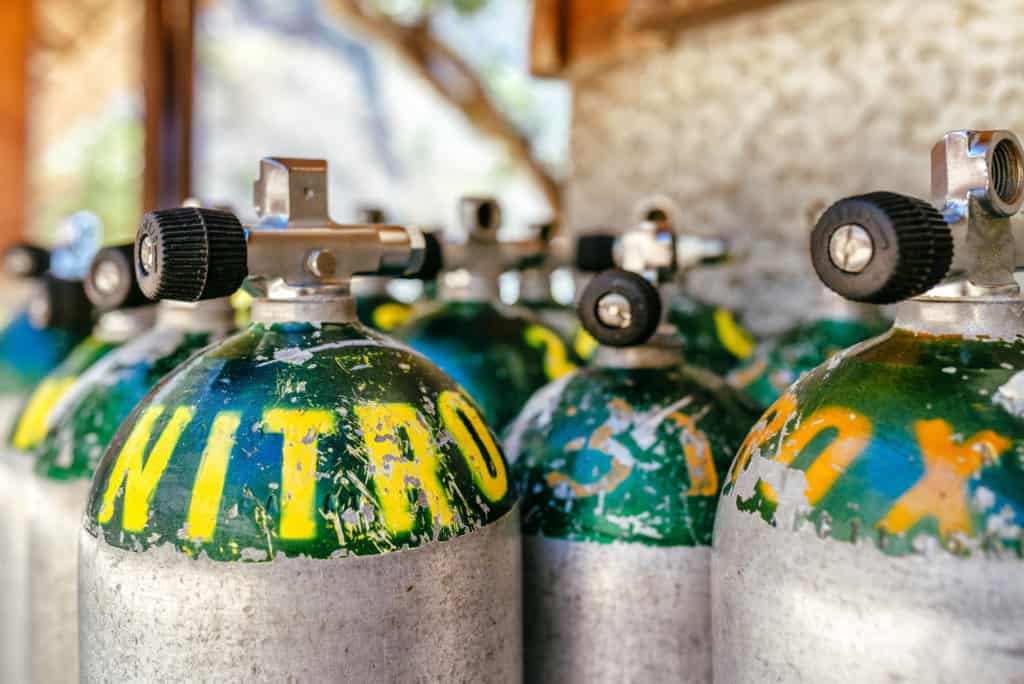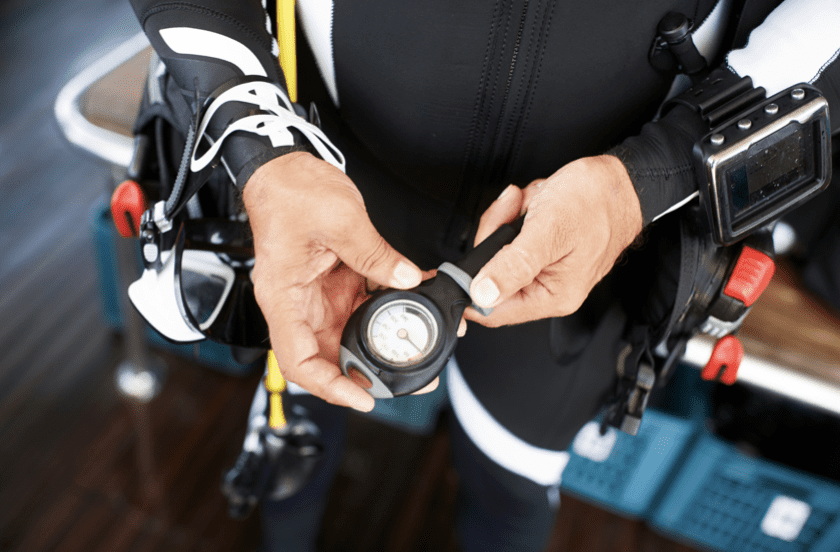As a diver, there are a lot of scuba acronyms that you need to learn which help you on your dives. From BWRAF to BCD! Do you know what each one means?
Scuba Acronym Cheat Sheet!
When you begin diving there are so many scuba acronyms you need to learn – it all gets a little bit confusing!
Especially when completing your open water course, it can feel like you’re constantly learning new acronyms for scuba in each step…
But did you also know that the word SCUBA itself is an acronym?
We’ll look at all these and more in our handy guide to scuba acronyms.
What Does Scuba Stand For?
Some words have a great etymology and history, which makes them what they are today. However, scuba is a little different. It’s not because our beloved sport was invented by a guy named Mr. Scuba! It’s an acronym:
S – Self
C – Contained
U – Underwater
B – Breathing
A – Apparatus
The sport of diving is named after the equipment needed to be able to breathe and explore underwater.
Other Important Scuba Acronyms
ADT – Actual Dive Time
This is the actual time that you as a diver spend underwater, it is important to know to help to calculate surface intervals and subsequent dive times using dive tables.
AOW – Advanced Open Water
The advanced open water is the second course in the PADI progression, it improves your dive skills and allows you to dive deeper.
BCD – Buoyancy Control Device
Your BCD is the “jacket” that you wear when scuba diving. It holds the tank and keeps your equipment together, while also being able to be inflated and deflated to allow you to remain buoyant.

BWRAF – BCD, Weights, Releases, Air, Final Check
BWRAF is used as a pre-dive safety check with a buddy. You can find out more about how to complete a BWRAF check in this blog.
We use the pre-dive safety check as well during Cenote dives!
CESA – Controlled Emergency Swimming Ascent
The CESA is an emergency skill that needs to be completed if a diver runs out of air. You are taught it during the open water course. If the diver has run out of air and their buddy is not close by, they need to swim to the surface slowly, while releasing bubbles from the mouth.
DIN – Deutsche Industrie Norm
DIN is a type of tank valve where the thread screws into the tank valve. Here in Mexico, you’ll commonly find both DIN and Yoke valves. DIN is more commonly used when cavern and cave diving.
DSD – Discover Scuba Diving
A Discover Scuba Dive is the first experience of dipping your toes into the world of scuba. It is a one-day ‘try dive’ that allows you to learn some basic skills and take a dive into the ocean under the very close and watchful eye of an instructor. It’s often a good idea to try a DSD before beginning your open water course to know that you will like it (Disclaimer: You probably will love it!)
DSMB – Delayed Surface Marker Buoy
A DSMB is a large, sausage-shaped tube that a diver will inflate at the end of the dive. It lets people on the surface know you are going to be there and helps the dive boats to find you as you surface.
EANx – Enriched Air Nitrox
Usually divers use air, just like the air we breathe daily when diving, which is 21% oxygen and 79% nitrogen. Enriched air (also known as nitrox) has a higher oxygen percentage which allows for a greater bottom time. It also helps to limit residual nitrogen forming in your body tissue.

EFR – Emergency First Response
As a diver, it’s also useful to know basic first response and first aid. To be a Rescue diver, you need to also train and complete a course in EFR.
IDC – Instructor Development Course
If you wish to become a diving instructor yourself, you must first complete many courses to become a Divemaster. You can then take an IDC to train to be an instructor.
LPI – Low Pressure Inflator
This is the hose on your BCD that attaches to your tank. You use it to inflate your BCD to help maintain perfect buoyancy.
MOD – Maximum Operating Depth
Your MOD is the deepest depth that a diver can safely immerse to. It is based on their gas mix, as certain gasses, such as nitrox can only be used up to a certain depth.
NDL – No Decompression Limit
This is a term more used by technical divers and is the time limit and depth limit that a diver must stick to avoid nitrogen absorption.
OW – Open Water
The open water course is the first diving certification level. Once completed, a diver can dive with a buddy, without professional supervision to a maximum depth of 18m.
RDP – Recreational Dive Planner
The RDP is also known as a dive table. You learn how to use a table in your OW course to help you to plan your maximum depth and dive time. (Although most modern dive computers will do this for you with more accuracy nowadays – it’s still important to know the principal behind the dive table)
RNT – Residual Nitrogen Time
The amount of Nitrogen that remains in your body when you complete repetitive dives affect your subsequent dive’s depth and time limit. Your RNT needs to be subtracted from the next dive to remain within no decompression limits.
SI – Surface Interval
Your surface interval is the amount of time you spend above water between your dives. In Mexico, we spend it on our dive boat chatting about the previous dive and getting ready for the next! It is important to spend enough time above the water between dives to reduce your RNT.
SORTED – Signal, Orientate, Regulator, Time, Equalize, Descend
SORTED helps you remember the steps to descend!
- Signal – Signal to your buddy that you’re ready to head below the water
- Orientate – Check your orientation using surface landmarks where applicable, and position your body to where you are going
- Regulator – Make sure it is in your mouth and you can breathe easily
- Time – make a note of the time to help you to dive your plan.
- Equalize & Elevate – Raise your low-pressure inflator hose and remember to clear your ears as you descend
- Descend!
SPG – Submersible Pressure Gauge
The SPG is the gauge that is attached to your tank to show you the remaining pressure. It is usually displayed in either PSI or BAR. You need to look at this gauge regularly to avoid running out of air.

STELA – Signal, Time, Extend, Look & Listen, Ascend
As well as an acronym to descend, there is one to ascend too – STELA.
- Signal – Signal to your buddy that you are ready to go up (with your thumb)
- Time – Check the time and ascend slowly at a rate of around 1 foot per second
- Elevate – Extend the arms, lifting the LPI above your head to release the expanding air in the BCD
- Look & Listen – Especially in bust places, be aware and check for boat traffic
- Ascend – Slowly and safely!
Training Agency Acronyms
There are also acronyms for the different training agencies you can learn to dive and complete your education with.
PADI – Professional Association of Diving Instructors
PADI is a globally known training agency for recreational divers. As a PADI-certified diver, you can dive worldwide.
SSI – Scuba Schools International
SSI is another large and popular recreational dive training agency. SSI and PADI qualifications are similar, and most dive shops will accept either certification.
NAUI – National Association of Underwater Instructors
NAUI is a recreational dive certification and membership organization established to provide international diver standards and education programs.
BSAC – British Sub Aqua Club (BSAC)
The British Sub-Aqua Club or BSAC has been the national governing body of recreational diving in the United Kingdom since 1954.
SDI – Scuba Diving International
Scuba Diving International is a Scuba training and certification agency. It is the recreational arm of Technical Diving International (TDI), a technical diver training organization.
DAN – Divers Alert Network
Although not a training agency, DAN is an association dedicated to scuba diving safety.
Practice Your Scuba Acronyms
Although it may seem tricky at first, with practice you’ll soon master the scuba acronyms on this list (and more!)
Come and learn them with us in the Mexican sunshine, while we dive into the beautiful oceans of Playa del Carmen, Cozumel, and the magical Cenotes near Playa del Carmen and Tulum.
Do you know any other scuba acronyms that we haven’t mentioned? Let us know in the comments.


